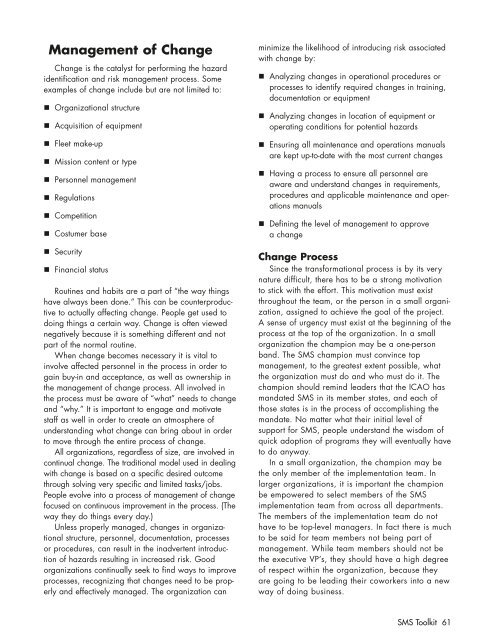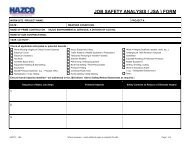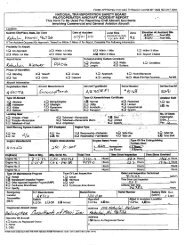International Helicopter Safety Team Safety Management System Toolkit
IHST - Safety Management Toolkit - Skybrary
IHST - Safety Management Toolkit - Skybrary
- No tags were found...
You also want an ePaper? Increase the reach of your titles
YUMPU automatically turns print PDFs into web optimized ePapers that Google loves.
<strong>Management</strong> of Change<br />
Change is the catalyst for performing the hazard<br />
identification and risk management process. Some<br />
examples of change include but are not limited to:<br />
Organizational structure<br />
Acquisition of equipment<br />
Fleet make-up<br />
Mission content or type<br />
Personnel management<br />
Regulations<br />
Competition<br />
Costumer base<br />
Security<br />
Financial status<br />
Routines and habits are a part of “the way things<br />
have always been done.” This can be counterproductive<br />
to actually affecting change. People get used to<br />
doing things a certain way. Change is often viewed<br />
negatively because it is something different and not<br />
part of the normal routine.<br />
When change becomes necessary it is vital to<br />
involve affected personnel in the process in order to<br />
gain buy-in and acceptance, as well as ownership in<br />
the management of change process. All involved in<br />
the process must be aware of “what” needs to change<br />
and “why.” It is important to engage and motivate<br />
staff as well in order to create an atmosphere of<br />
understanding what change can bring about in order<br />
to move through the entire process of change.<br />
All organizations, regardless of size, are involved in<br />
continual change. The traditional model used in dealing<br />
with change is based on a specific desired outcome<br />
through solving very specific and limited tasks/jobs.<br />
People evolve into a process of management of change<br />
focused on continuous improvement in the process. (The<br />
way they do things every day.)<br />
Unless properly managed, changes in organizational<br />
structure, personnel, documentation, processes<br />
or procedures, can result in the inadvertent introduction<br />
of hazards resulting in increased risk. Good<br />
organizations continually seek to find ways to improve<br />
processes, recognizing that changes need to be properly<br />
and effectively managed. The organization can<br />
minimize the likelihood of introducing risk associated<br />
with change by:<br />
Analyzing changes in operational procedures or<br />
processes to identify required changes in training,<br />
documentation or equipment<br />
Analyzing changes in location of equipment or<br />
operating conditions for potential hazards<br />
Ensuring all maintenance and operations manuals<br />
are kept up-to-date with the most current changes<br />
Having a process to ensure all personnel are<br />
aware and understand changes in requirements,<br />
procedures and applicable maintenance and operations<br />
manuals<br />
Defining the level of management to approve<br />
a change<br />
Change Process<br />
Since the transformational process is by its very<br />
nature difficult, there has to be a strong motivation<br />
to stick with the effort. This motivation must exist<br />
throughout the team, or the person in a small organization,<br />
assigned to achieve the goal of the project.<br />
A sense of urgency must exist at the beginning of the<br />
process at the top of the organization. In a small<br />
organization the champion may be a one-person<br />
band. The SMS champion must convince top<br />
management, to the greatest extent possible, what<br />
the organization must do and who must do it. The<br />
champion should remind leaders that the ICAO has<br />
mandated SMS in its member states, and each of<br />
those states is in the process of accomplishing the<br />
mandate. No matter what their initial level of<br />
support for SMS, people understand the wisdom of<br />
quick adoption of programs they will eventually have<br />
to do anyway.<br />
In a small organization, the champion may be<br />
the only member of the implementation team. In<br />
larger organizations, it is important the champion<br />
be empowered to select members of the SMS<br />
implementation team from across all departments.<br />
The members of the implementation team do not<br />
have to be top-level managers. In fact there is much<br />
to be said for team members not being part of<br />
management. While team members should not be<br />
the executive VP’s, they should have a high degree<br />
of respect within the organization, because they<br />
are going to be leading their coworkers into a new<br />
way of doing business.<br />
SMS <strong>Toolkit</strong> 61







